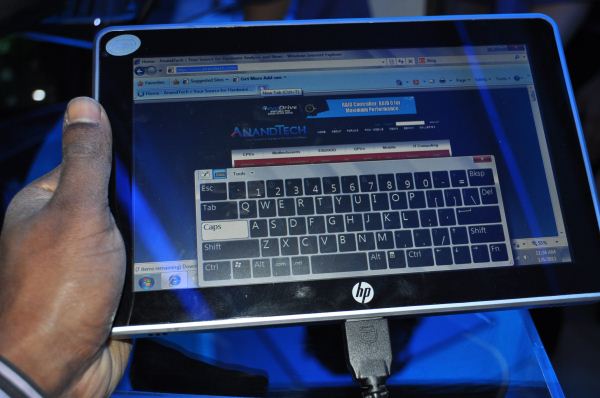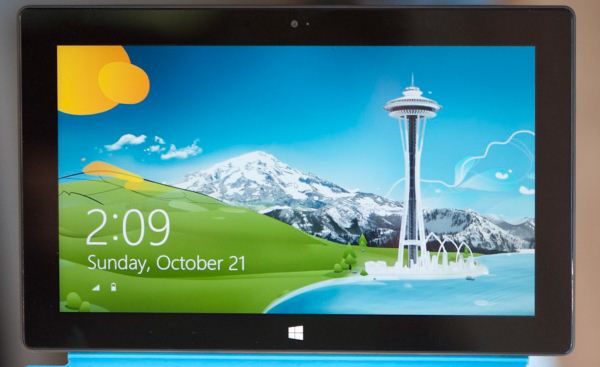The Windows RT Review
by Vivek Gowri & Anand Lal Shimpi on October 25, 2012 12:00 PM EST- Posted in
- Windows RT
- Operating Systems
- Microsoft
- Mobile
- Windows 8
- Tablets
Meet Windows RT
Microsoft’s first serious foray into tablets came just after the turn of the new millenium, with Bill Gates demonstrating the first tablet PC prototype onstage at Comdex in the autumn of 2000. From there, OEMs started releasing tablets based on Windows XP Tablet PC Edition in 2002, with a full range of pen-enabled slates and convertibles releasing over the next few years. In addition to oftentimes prohibitive cost, each had its own set of drawbacks. Convertibles tended to be quite bulky compared to their notebook counterparts (the ThinkPad X-series being a notable exception), while slates were rather difficult to use - a symptom of shoehorning a desktop operating system into a purely touch-centric form factor.
Fast forward a decade, to the beginning of 2010. After a number of conceptual non-starters in the tablet PC space - building tablet PC support into all editions of Windows Vista and 7 (other than Basic/Home Starter), the entire Origami class of devices - Microsoft’s touchscreen devices were floundering. The iPad had been announced to mixed reaction but an extremely high level of anticipation. Microsoft and HP countered with the Slate 500, an Atom-based device shown off at CES 2010 with solid state storage and Windows 7 in roughly the same form factor as Apple’s iPhone OS-based ARM tablet. With speculation pointing to a pricetag of just $549, the Slate appeared to be the most viable hope Microsoft had in trying to make mainstream headway with the tablet PC concept. But shortly after the iPad shipped in April 2010, rumors of the Slate’s demise started to circulate, and after a six month delay, the Slate 500 started shipping as an enterprise-only product in December of that year for $799. HP’s acquisition of Palm (RIP) definitely played a role in the sidelining of the Slate, but more importantly, it essentially spelled the end for the tablet PC. This was news that was perhaps known already, but the Slate saga officially pulled the plug on Microsoft’s original idea of what a tablet was.
The problem was two parts software, one part hardware. Microsoft had developed a very interesting touch-oriented user interface for its handhelds, so at least one part of the equation was relatively straightforward. The hardware issue came down to this: the iOS and Android tablets succeeding in the market ran off ARM system-on-chips, which resulted in slim, power-efficient tablets that had idle times stretching for days. At the time, there was just nothing in terms of x86 hardware that could compete with that in low-power device realm (Clover Trail and Haswell, of course, change this part of the story considerably). The other question? How to converge the touch-centric UI with the classic desktop environment that had been the corner of Windows dating all the way back to 95.
Meet Windows RT. It’s Microsoft’s first major foray into the modern tablet market, the shipping version of Windows-on-ARM, and it’s one of Microsoft’s most important product launches ever. Windows 8 shares the same touch-friendly user interface, but the ARM silicon makes RT an almost entirely tablet-centric operating system, the first for Microsoft. Combined with the focus on premium hardware experiences, this is Redmond’s most serious push to be competitive with the iOS and Androids of the world. How does it fare? Keep reading.












233 Comments
View All Comments
othercents - Thursday, October 25, 2012 - link
I really wish you could have looked closer at Live Messenger and specifically Video. My parents use Live Messenger since it is easy for them and so do most of the people I know internationally. Skype is a great application, however for them it isn't easy or familure. This is why I continue to need Live Messenger while still using Tango for most phone to phone calls. The best option would be to have Live Messenger Video available on my WP7, but it is just chat and even then some messages just don't get through.Alchemy69 - Thursday, October 25, 2012 - link
If they were going to release on OS specifically for the tablet market why bother including Metro with Windows 8 when it is so obviously geared for touchscreens?Spivonious - Thursday, October 25, 2012 - link
Honestly, the Metro UI is not that hard to use with a mouse.karasaj - Thursday, October 25, 2012 - link
I don't know why people find metro so weird - instead of having a ~90*400 or whatever pixel menu that gives you 10 programs to select, you have all your programs, and you can STILL just type away and the search function works exactly as it does in win7, you don't actually have to type anything extra.Windows key + calc + enter would still bring up the calculator, for example.
Vivek and Anand got it right imo - think of it as a glorified start menu.
ludikraut - Thursday, October 25, 2012 - link
While it's not hard, per-se, to me it feels awkward with a mouse, but just about perfect on a touch screen. IMO the icons are way too large for desktop mouse use - especially when you're used to hitting 1/4" icons on a 40" screen. :-pl8r)
Penti - Thursday, October 25, 2012 - link
You could always use a touch mouse like those from Microsoft, they are just not doing anything to promote it or it's usage scenarios i.e. gestures via mouse or trackpad. Capactive touch on a notebook-formfactor does nothing really so I don't get why they just don't turn to gestures, Apple handle that fine. With a touch mouse you can get all the Windows 8 functionality even if they assume you use fingers. Like charms, switching apps, app commands, scroll left to right and so on. But the MS Touch Mouse is also a 80 dollar device which ships with no systems.So sadly they fail to grasp how users will use these systems. Even though they do promote keyboard and multi-touch trackpad with the Surface. You really understand why major companies, component suppliers and OEM's are wary when it's an unpolished mess. I get why they try to target touch, just not why they try to just fill that space by putting an separate environment on top of the other and keeping them as separate ecosystems which are very hard to move between it's easier to port to an entirely different system which isn't an abstraction of Win32! If you don't innovate with gestures and new navigational features across the whole system it just seems stupid. You quickly get ten ways to do the same thing also. It would have made more sense if it didn't try to be Windows.
Dorek - Friday, November 2, 2012 - link
New Windows 8 machines have touchpad gestures that mirror the on-screen gestures. It's up to trackpad manufacturers to update their drivers to support gestures on older devices, but I assume many of them will.Da W - Thursday, October 25, 2012 - link
I think people underestimate the numbers of apps we're likely to see in the future. Windows phone 7 library grew to over 100000 apps despite having miserable number of units sold in the market. We will see more surface tablets and Windows 8 computers sold in the next 3 month than Windows Phone 7 ever has. The market for developper is there.Consider also the languages being supported here. You know C#, VB.net, Java, HTML5, you can do a metro app. I guess many Windows software can be recorverted to metro relatively easily. I'm not a developper, i'm just a geek and an economist, but i think Microsoft has the most developper-friendly environment out there. And many, many webservices like netflix, facebook, pulse will have a metro app down the road. Many, many iOS / Android apps are little more than rebagadged web pages after all. So you will see them on Windows 8/RT, and even more, the existance of these apps, like netflix being i think more beautiful in Metro than in a web browser, will become a reason for people to upgrade to Windows 8.
Sure the era of Microsoft monopoly over computing devices is over. But there are today some 1.3 billions PCs out there versus 100million iPads, the battle is not over by a wide margin.
That being said, i'm still waiting for my Haswell tablet with a Wacom digitizer.
Spivonious - Thursday, October 25, 2012 - link
You would want to redo the UI to work better with touch, but all of the backend code can stay exactly the same.I think we'll see the marketplace explode with Win8 apps, especially if sales continue to be good.
ludikraut - Thursday, October 25, 2012 - link
You're spot on. App development for Metro is about as easy as it gets. Much easier than IOS, IMO.Ditto for waiting on a Haswell tablet with Wacom digitizer.
l8r)